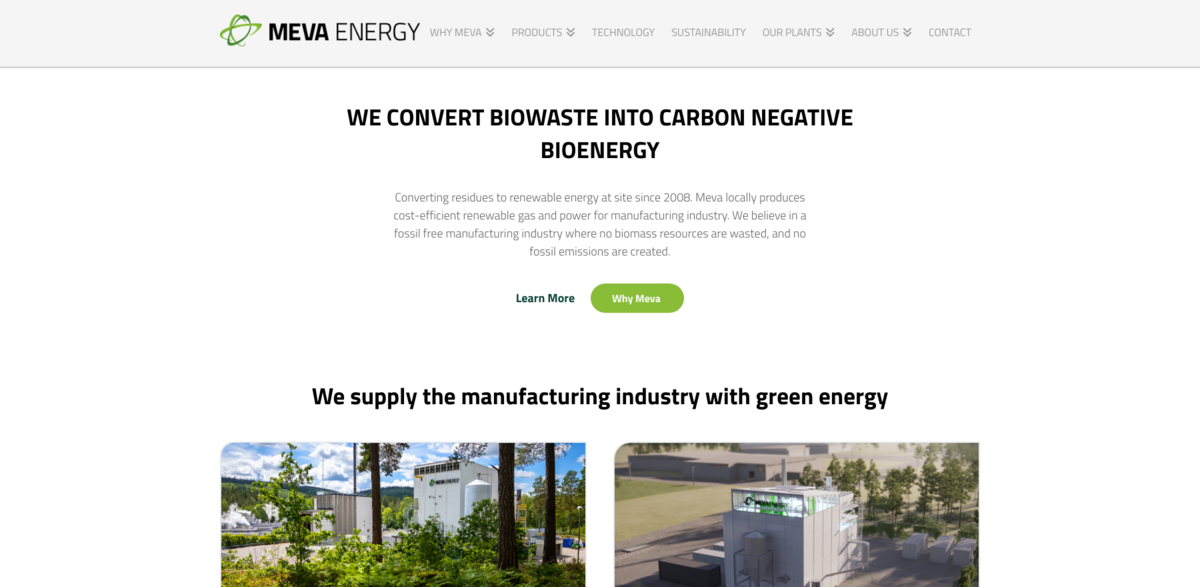Meva Energy: Revolutionizing Renewable Energy for Manufacturing
Meva Energy has been converting biowaste into carbon-negative bioenergy right at the site since 2008. Their mission? To power the manufacturing industry with cost-efficient, renewable gas and electricity, all while cutting out fossil emissions and wasting zero biomass resources. Imagine a fossil-free manufacturing world where residues from production processes aren’t trash but treasure. That’s exactly what Meva is making happen.
The Main Benefit: Green Energy That Makes a Real Difference
Meva Energy’s technology is already making waves, replacing fossil gas at places like Sofidel Sweden’s tissue mill in Kisa. Plus, IKEA’s furniture production residues get a second life as renewable power and heat, sent right back to the factory. Here’s why this matters:
- Operating since 2008 with on-site residue conversion
- WWF estimates potential to save 75 million tonnes of fossil CO2 emissions annually — that’s 1.5 times Sweden’s total CO2 emissions!
- Locally produced renewable gas and power reduce transport and energy losses
- Supports a circular economy by turning waste into valuable energy
- Offers both Energy Purchase Agreements (EPA) and turnkey plant ownership options
How Meva’s Technology Works: From Biomass to Biosyngas
Industries processing solid biomass like wood generate tons of biomass residues. Instead of letting these go to waste, Meva uses thermochemical gasification — heating biomass in an oxygen-limited environment — to create biosyngas and biochar. Biosyngas is a clean, energy-rich gas that replaces fossil fuels, while biochar acts as a carbon sink when added to soils. It’s a win-win: clean energy plus carbon capture.
Entrained Gasification: Maximizing Efficiency and Feedstock Flexibility
At the heart of Meva’s system is the gasifier reactor, operating on the entrained flow principle. Biomass particles are continuously fed into a hot, oxygen-deficient environment, producing stable, high-quality gas with minimal variation. The system can handle a wide range of feedstock, including larger scraps processed through milling or drying, and fine fractions like MDF and sawdust — as long as particles are smaller than 2mm. This flexibility means industries can decarbonize without sacrificing quality or cost.
Biomass: A Reliable, Circular Energy Stream
Biomass gasification taps into organic residues from agriculture, forestry, and industry — all part of natural and industrial cycles. These feedstocks are generated predictably throughout the year, making biomass a consistent and dependable energy source. The process creates a closed-loop system that minimizes waste and maximizes resource efficiency. It’s renewable energy that’s as reliable as it is green.
Project Impact: Aligning with Global Sustainability Goals
- SDG 7: Affordable and Clean Energy — providing renewable gas and power
- SDG 9: Industry, Innovation, and Infrastructure — advancing sustainable industrial processes
- SDG 12: Responsible Consumption and Production — turning waste into resources
- SDG 13: Climate Action — reducing greenhouse gas emissions and enabling negative emissions
- SDG 15: Life on Land — promoting carbon sequestration through biochar use
On-Site Energy Solutions: Flexibility and Convenience
Meva Energy plants are strategically located right where the energy is consumed — at the customer’s site. This local approach cuts down on unnecessary transport and energy losses. Customers can choose an Energy Purchase Agreement, where Meva builds, owns, and operates the plant, delivering predictable, low-emission energy with no upfront investment or operational hassle. Or, for those who want full control, a turnkey solution offers a customized, ready-to-run facility integrated seamlessly into production. Either way, it’s about making renewable energy easy and accessible.





















